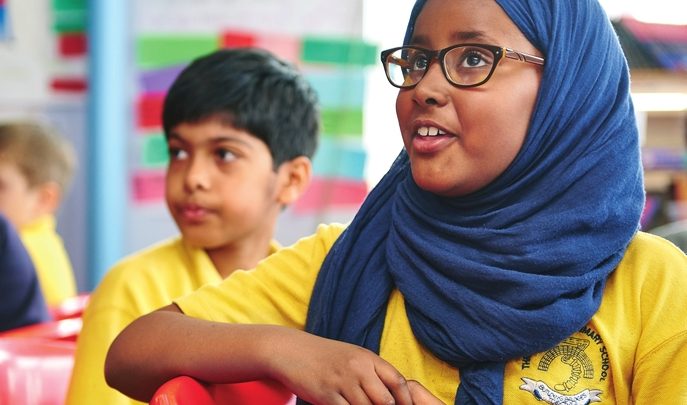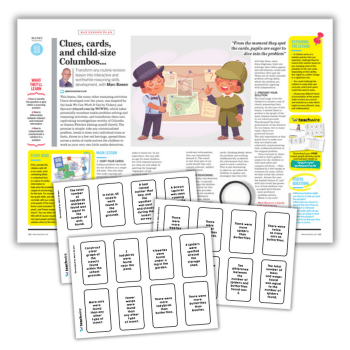“I Wanted To Challenge Them” – How One West London Primary Made The Transition To Singapore Maths

Switching to Singapore maths isn’t easy – but as practice at Three Bridges Primary School illustrates, with good leadership and a skilled teaching staff, it can transform children’s learning, says Jacob Stow…
- by Jacob Stow
- Former editor of Teach Early Years and Top School Trips magazines

Making changes isn’t always easy, particularly in schools, where feelings on how best to do things can run high and any missteps can have consequences for children’s learning (and headteachers’ careers).
But just as hard can be recognising that a change of tack is necessary in the first place – there’s something comfortable about the status quo; if it ain’t broke, don’t fix it, as they say. Kudos, then, to Three Bridges Primary School in Southall, west London, where finding better ways to educate is part of the culture, and staff are kept on board every step of the way. Of course, it has taken time and hard work to get this point…
“It wasn’t usual in 2002 for any school to be particularly innovative in terms of pedagogy and moving teaching and learning forward,” remembers headteacher, Matthew Burdett (right), then fresh to the Three Bridges job. “The  expectation that headteachers would do that just wasn’t there. I’d had a very leading role as a deputy, and I knew what I wanted to do in certain areas, but I didn’t quite grasp the freedom that I had. It was a learning process for me.
“Around 2007,” he says, “I realised we were just plodding along here. Our results were okay, but not sparkling. The children were very compliant, but they weren’t engaging in learning. They were empty vessels that we were filling. They weren’t being challenged, and I wanted to change that.”
The shift in approach at Three Bridges has seen the adoption of new pedagogies and methods, and the cultivation of a willingness amongst teachers to embrace a challenge – strategies have been developed to secure staff buy-in, ensuring new ideas work long term, rather than fizzling out when enthusiasm wanes. And nowhere is the can-do attitude more obvious than in the school’s decision to switch to Singapore maths, which is being rolled out across the school to impressive effect.
expectation that headteachers would do that just wasn’t there. I’d had a very leading role as a deputy, and I knew what I wanted to do in certain areas, but I didn’t quite grasp the freedom that I had. It was a learning process for me.
“Around 2007,” he says, “I realised we were just plodding along here. Our results were okay, but not sparkling. The children were very compliant, but they weren’t engaging in learning. They were empty vessels that we were filling. They weren’t being challenged, and I wanted to change that.”
The shift in approach at Three Bridges has seen the adoption of new pedagogies and methods, and the cultivation of a willingness amongst teachers to embrace a challenge – strategies have been developed to secure staff buy-in, ensuring new ideas work long term, rather than fizzling out when enthusiasm wanes. And nowhere is the can-do attitude more obvious than in the school’s decision to switch to Singapore maths, which is being rolled out across the school to impressive effect.
Finding inspiration
Back in 2007, having decided that change was necessary, Matthew’s focus became what to change to. At Three Bridges, the journey towards engaging children in their learning began with the University of Exeter’s Thinking School status, an award that recognises staff and students’ commitment to thinking “reflectively, critically and creatively, and to employing these skills and techniques in the co-construction of a meaningful curriculum and associated activities”. “It helped to change teachers’ mindset – to thinking that children have autonomy over their learning,” Matthew says. “From that point things began moving. We started looking for any good ideas from around the world. Where is good teaching and learning taking place?
‘We read up about it, and visited other schools. You talk to colleagues in a more strategic manner – not just moaning about the problems you have in school! Then you go on courses and decide: is this a good way forward or not?” From the outset, there was a recognition that there was no simple answer to the question of pupil engagement. “It’s not about listening to a colleague who’s doing something great in maths, then taking the whole system and trying to apply it in your own school,” Matthew says.
“That’s not going to work because every school is different – and a lot of these programmes have faults in them anyway. You’ve got to stay open-minded, and know exactly why you are making a change – and it should always for the betterment of the children, not because it’s the flavour of the month, or that it’s going to make anyone’s life easier.” After Thinking Schools came Assertive Mentoring, an approach that tasks children with setting personalised targets, and Balanced English, “a way of taking reading into writing”, utilising high-quality texts: “You’re modelling, you’re demonstrating, you’re picking up a particular strategy through the reading that leads into your writing, and we incorporate Pie Corbett’s Talk for Writing into that,” Matthew explains. Then came Singapore maths, which has perhaps meant the greatest change of all for staff, and, arguably, is having the most striking impact in the classroom.
2. Singapore maths
“We knew we wanted something different in our maths,” says Matthew. “Our results were fine, but we weren’t making mathematicians; we were creating people who could pass the tests. We wanted to help children find the joy in maths and develop their own number sense.
‘Again, we looked around the world, saw that Shanghai and Singapore were leading in maths, and so decided to look in more detail at what they were doing. We went to a Singaporean maths day conference and were really intrigued – it seemed to fit perfectly into our philosophy of education. We went away and learnt more about it ourselves, and become convinced it could work for us.” With its emphasis on textbooks and structured approach, Singapore maths has a reputation in some quarters of being didactic, which doesn’t sound particularly engaging – but pupils at Three Bridges have never been more involved in their learning, and are being given the tools they need to understand a subject that many struggle with. That said, lessons are based on a formula: ‘anchor tasks’ kick off each session, introducing the learning for the day, including methods of varying complexity to solve the problem at hand; journaling activities follow, providing a chance for written reflection, before the aforementioned textbooks are introduced, giving children further opportunities to reflect on different strategies. As the session progresses, those who feel confident are left to tackle problems alone while others receive more guided practice. Finally, differentiation tasks – “children might be making a visual model, writing an explanation, or creating a word problem or a series of problems similar to those they’ve just studied,” Deputy head, Jeremy Hannay, explains – are carried out, allowing teachers to later assess who has ‘got it’ and who is still struggling. Those who may not have grasped the concept benefit from a 30-minute intervention session to prepare them for the next day’s learning, which, in keeping with the mastery philosophy, builds incrementally on the day before, ensuring no gaps in understanding emerge. Challenge is ever-present, pitched at what children are capable of taking on.
3. Teaching understanding
Speak to the teaching staff at Three Bridges and their enthusiasm for Singapore maths quickly shines through. “The children are so used to understanding things now that they won’t accept it you just tell them ‘This is how it is, remember it,’” says Y6 teacher Emma Valério.
“Last year I had a group of children who were doing Level 6 maths, and I couldn’t tell them why Pi r squared is the area of a circle – they didn’t like it, they needed to know why. They’re retaining things better as a result, because they understand why things work.” Its benefits are being felt across the curriculum, too: “The impact it’s had on the children’s use of language, their speaking, in nursery and Reception has been amazing,” AHT, SENCO and Foundation Stage teacher, Jo Williams tells us. “Their ability to articulate their thoughts is crazy. It’s down to the different style of teaching, the emphasis that the first point should come from the pupils.
‘They’re given a problem, but it’s up to them to talk to their partner, to work through what they think the answer is going to be. We’re now talking about how we can introduce this enquiry based, problem-solving way of teaching into other subjects.” But one thing Singapore maths hasn’t been is easy for teachers: “You have to really anticipate what’s going to go wrong,” Matthew notes. “You need to be thinking, ‘this group of learners, they’re quite able, so they’re going to rush ahead – how am I going to keep them involved in the learning?’ Or ‘what did I miss that day? How can I question children differently to help them learn?’ It requires teachers to have a high intellectual capital, and fortunately we’ve got that here.” Support is available, though, and it’s an intrinsic part of the approach: “For our teachers, the textbooks we have give a breadth of understanding about the subject that you wouldn’t necessarily have unless you were a mathematical specialist,” Jeremy explains. “In primary schools, we expect our teachers to be able to instruct in English, maths, science, history, geography, French – all the subjects. But there’s no possible way teachers can be masters of them all.
‘In Singapore maths, the textbooks provide the expertise they need to make informed but autonomous decisions. It’s a map you can use to help children reach the same destination using different roads – some will be more treacherous and challenging, and for your advanced learners that might be what they need to take on that day, while for struggling learners, the road might be much more direct.”
4. In at the shallow end
Resistance from staff is often the biggest hurdle a proactive headteacher can face, and when teachers are asked to work in an entirely new way, as necessitated by the introduction of something like Singapore maths, you might expect it to rear its head – but at Three Bridges a great deal of effort goes into making sure changes are accepted and then embraced. Whereas in the current school improvement climate there is often pressure to act swiftly, here the approach is more measured, and more sustainable as a result. “We have many long conversations about when and how to introduce something new,” Matthew says. “We’re constantly assessing and reviewing the pace of change, and if it’s too much, we’ll withdraw for a couple of weeks. It gives staff a chance to breathe and reassess, then we’re ready to move forward again. We’re very clear on where we want to go, but if it takes a whole year to get there, it takes a whole year – I don’t mind.” “When we introduce something new, we give staff a chance to play with it first, and reassure them that no one will be coming in to scrutinise what they’ve been doing,” Jeremy explains. “In two or three weeks, we’ll come back and have a conversation about it. What went well?
‘Ultimately, what ends up happening is that the teachers begin to shape the programmes we’re creating. They start to see evidence of the new approaches working, and come to the conclusion that it’s what we should be doing. An entire pedagogical shift has taken place without ever having to use scrutiny or accountability measures on professional people. What that creates is teachers who go into classrooms and behave in exactly the same way with children.
‘The opposite of that is what happens in a lot of schools, and I think that᾿s really dangerous – where headteachers bring in things they’ve seen or done elsewhere, and if it doesn’t work, it gets blamed on the staff. “We’ve never had a situation in the last four years where we’ve needed to make a pedagogical shift and everybody has been against it,” he stresses. “Sometimes there will be one or two dissenting voices. But then what happens is teachers begin having conversations with teachers – often when a teacher finds something isn’t working for them, a colleague will come along and show how they’ve made it work. They’ll talk it over and lend them a hand. All of a sudden teachers are supporting teachers. It doesn’t need to be something the management forces through.”
Leading change
At Three Bridges, change is a collaborative process – “It takes a team of really highly skilled, passionate, intellectual, motivated people to move a school forward,” as Jeremy puts it. But that doesn’t mean clear leadership isn’t required to make it a success, as Matthew found during an aborted first attempt to introduce Talk for Writing to the school. “I asked two subject leaders to go off and research it. They attended a Pie Corbett conference and came back feeling fantastic about it,” he explains. “But I found that because I hadn’t taken the time to go and understand the approach, I couldn’t assess it, or lead the process.
‘After a year of doing quite badly in the school, it withered and died – it had become corrupted, and people were missing the point. The crucial message I took from that was that if you’re going to make changes in the school, you need to have full knowledge and understanding of what it’s all about.”
Meet the staff
 Emma Valério – Y6 teacher
“The textbooks are expertly written, though you can always add to and change them. I’m the maths leader, but I couldn’t plan lessons with the variation demonstrated in the textbooks. And without them, I might be planning brilliant lessons, and another teacher might be planning brilliant lessons, but that doesn’t necessarily mean one is laying the foundations for the other. Having one long story is important.”
Emma Valério – Y6 teacher
“The textbooks are expertly written, though you can always add to and change them. I’m the maths leader, but I couldn’t plan lessons with the variation demonstrated in the textbooks. And without them, I might be planning brilliant lessons, and another teacher might be planning brilliant lessons, but that doesn’t necessarily mean one is laying the foundations for the other. Having one long story is important.”
 Jeremy Hannay – Deputy Head
“The phrase that I’ve always liked is, ‘Do we teach children to read without books?’ No, we don’t. That would be crazy. So why do we teach children to read mathematics without a book? During our Singapore maths sessions, the children get opportunities to look through the textbooks and read mathematics. It’s helping them uncover a different way of understanding the subject.”
Jeremy Hannay – Deputy Head
“The phrase that I’ve always liked is, ‘Do we teach children to read without books?’ No, we don’t. That would be crazy. So why do we teach children to read mathematics without a book? During our Singapore maths sessions, the children get opportunities to look through the textbooks and read mathematics. It’s helping them uncover a different way of understanding the subject.”
 Jo Williams – Foundation Stage teacher
“Something that makes we really happy working here is that it’s a really supportive school to work in. I came back from working elsewhere into a lot of changed programmes, but the support and the discussion that’s gone with those changes, the range of evidence we’re given to read and discuss, has meant that I’ve felt a part of them.”
Jo Williams – Foundation Stage teacher
“Something that makes we really happy working here is that it’s a really supportive school to work in. I came back from working elsewhere into a lot of changed programmes, but the support and the discussion that’s gone with those changes, the range of evidence we’re given to read and discuss, has meant that I’ve felt a part of them.”
 Dean Lynch – Y2 teacher
“We do something called the minimal step progression, so children move at a slower pace than we might have done in the past. This allows more time for exploration, and for children to gain more of a relational understanding between the things they’re doing and things they’ve done before. We’re moving more slowly through the curriculum, but the depth children are getting is invaluable.”
Dean Lynch – Y2 teacher
“We do something called the minimal step progression, so children move at a slower pace than we might have done in the past. This allows more time for exploration, and for children to gain more of a relational understanding between the things they’re doing and things they’ve done before. We’re moving more slowly through the curriculum, but the depth children are getting is invaluable.”
Pupil voice
Ayah “We have a new thing called a journal – after a lesson we write in our journal about what we understood from it. We have to give an example. It helps; I don’t just hear how I understand it, I write how I understand it.”
James “We try to find more than one solution to the same problem. If we find one way to do it, and some people are still struggling, we’ll try to find another way to solve the same problem. It helps us get used to all the different methods.”
Aneal “Before, maths was really simple. We didn’t have journals or textbooks, just one book for everything. Now we use bar models so we can visualise the questions, but before we did everything mentally, or with column addition or subtraction.”
Ellie “I find bar modelling very helpful when we’re doing ratio. It helps you to visualise the numbers. When you see it written out, it can be confusing.”










